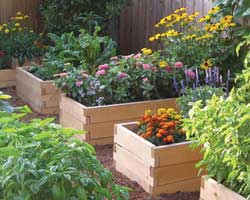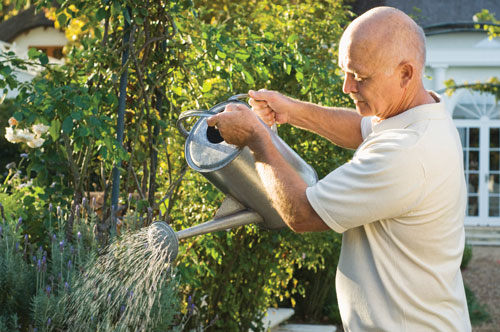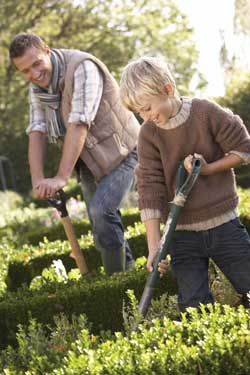
Raised Beds
Download a PDF of this factsheet.
What is a raised garden bed?

A raised garden bed brings the garden up to a comfortable height for the gardener. Since it raises the garden off the ground, you will not have to bend and reach as much, if at all. A raised bed is usually a rectangular box that sits on the ground and holds soil. Its height can range from six inches to waist high. It usually has a frame made of wood, stone, concrete, or brick. Gardening can be done while sitting or standing. Dimensions can be short, long, low, high; whatever fits YOU.
Wood is often used as the bed's frame because it is low-cost, widely available, and easy to work with. However, longlasting wood is expensive. Shorter-lasting wood is cheaper, but will need to be replaced every three to five years.
General Measurements
The raised bed can be built to any size that is comfortable for the gardener. Raised beds are not one-size-fitsall. However, there are some general measurements that seem to work well for most people. You may want to keep these in mind:
- Most raised beds are around four to five feet wide, or about two feet from the side to the center of the bed. This width lets people comfortably reach and tend the center of their garden.
- A raised bed's average height is six inches to one foot. Gardeners who use walking aides, wheelchairs, or have a hard time kneeling or bending, find raised beds between these heights helpful. Beds that are 18, 24 or 30 inches high work well for gardeners who are tall or have difficulty using their arms and hands. The height to which you build your raised bed should not be so high that your arms are working at an uncomfortable height. Keep your arms between your waist and shoulders while garding. This keeps you from tiring easily and helps prevent injury.
- Raised beds tend to be about two feet high for gardeners who use wheelchairs.
- You can also build raised garden beds on legs so you can sit facing the bed more comfortably. Beds that are three feet off the ground give plenty of space for leg room.

Planting Tips
- Gardens planted in small blocks, also called wide row planting, work well in raised beds. Wide row planting puts plants closer together. This crowds out weeds and shades the soil. This is important because soil in raised beds dries out quickly.
- General planting designs for raised beds put the tallest plants in the center or at the back of the bed. Plants are then arranged from tallest to shortest as you work your way to the side or front of the bed.
- Petunias, marigolds, snap dragons, pansies, impatiens, and salvia are some annuals that grow well in a raised bed.
- Alyssum and petunias are great examples of plants that can drape over the bed's edge.
- Flowers, bulbs, and herbs grow well in raised beds that are six to eight inches deep. Lettuce, leeks, beets, spinach, garlic, radishes, peas, kohlrabi, turnips, greens, strawberries, cucumbers, and watermelon also grow well in this soil depth.
- Eight to ten inch soil depth is good for corn, squash (including pumpkins), peppers, green beans, broccoli, cabbage, Brussels sprouts, melons, carrots, eggplant, and cauliflower.
- Raised beds that are one to two feet deep are good for growing potatoes.
- Black-Eyed-Susans, ornamental grasses, daises, and dwarf irises are perennials that grow well in raised beds.
- Perennials seem to grow better in soil depth of ten inches and deeper
Tricks and Tips

- Full sun may be harmful, even for sun loving plants, because raised beds dry out quickly.
- Soil can stain. Keep this in mind if you plan to put your raised bed on concrete or a patio.
- You may need to build a walkway if you plan to build your raised bed far from buildings, sidewalks, or in a grassy area. Walkways that are made of hard and flat materials, like concrete and brick, are easiest for everyone to walk on and roll walking aides on.
- Make sure there is water access close to your raised bed.
- Gardeners' legs may be scraped by brushing against bed frames made of stone or concrete. This is especially important to keep in mind for gardeners who have little or no feeling in their legs.
- Remember that soil, especially when wet, and plants are very heavy. Make sure that your deck, rooftop, or balcony can support the bed's weight.
- Grab bars attached to the sides of raised beds can be useful. Grab bars can help people stand up from sitting while gardening or help people stand while gardening.
- Most people find that gardening in raised beds is more comfortable when standing facing the bed and leaning slightly into it. Another comfortable position is to sit alongside the bed and reach to the side and forward at a 45 degree angle into the bed. Gardeners find these positions more comfortable than sitting on the edge of the bed's frame and twisting at the waist while gardening.
Resources
You can make your own raised bed or you can buy a kit. If you are interested in building your own raised bed, check out:
- Building Wheelchair Accessible Raised Garden Beds at www.dowlingcommunitygarden.org
- Accessible Gardening for People with Physical Disabilities, a book by Janeen Adil.
- http://anr.ext.wvu.edu/lawn_garden/vegetable_gardening/gardening_with_raised_beds
If you would like to talk to someone about accessible gardening, or would like a garden assessment done, call Green Tumbs, Healthy Joints at 800-841-8436.

